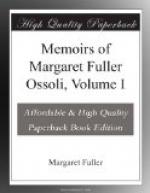First led perhaps by Goethe, afterwards by the love she herself conceived for them, she read everything that related to Michel Angelo and Raphael. She read, pen in hand, Quatremere de Quincy’s lives of those two painters, and I have her transcripts and commentary before me. She read Condivi, Vasari, Benvenuto Cellini, Duppa, Fuseli, and Von Waagen,—great and small. Every design of Michel, the four volumes of Raphael’s designs, were in the rich portfolios of her most intimate friend. ‘I have been very happy,’ she writes, ’with four hundred and seventy designs of Raphael in my possession for a week.’
* * * * *
These fine entertainments were shared with many admirers, and, as I now remember them, certain months about the years 1839, 1840, seem colored with the genius of these Italians. Our walls were hung with prints of the Sistine frescoes; we were all petty collectors; and prints of Correggio and Guercino took the place, for the time, of epics and philosophy.
In the summer of 1839, Boston was still more rightfully adorned with the Allston Gallery; and the sculptures of our compatriots Greenough, and Crawford, and Powers, were brought hither. The following lines were addressed by Margaret to the Orpheus:—
’CRAWFORD’S ORPHEUS.
’Each Orpheus must to the abyss
descend,
For only thus the poet can
be wise,—
Must make the sad Persephone his friend,
And buried love to second
life arise;
Again his love must lose, through too
much love,
Must lose his life by living
life too true;
For what he sought below has passed above,
Already done is all that he
would do;
Must tune all being with his single lyre;
Must melt all rocks free from
their primal pain,
Must search all nature with his one soul’s
fire;
Must bind anew all forms in
heavenly chain:
If he already sees what he must do,
Well may he shade his eyes from the far-shining
view.’
Margaret’s love of art, like that of most cultivated persons in this country, was not at all technical, but truly a sympathy with the artist, in the protest which his work pronounced on the deformity of our daily manners; her co-perception with him of the eloquence of form; her aspiration with him to a fairer life. As soon as her conversation ran into the mysteries of manipulation and artistic effect, it was less trustworthy. I remember that in the first times when I chanced to see pictures with her, I listened reverently to her opinions, and endeavored to see what she saw. But, on several occasions, finding myself unable to reach it, I came to suspect my guide, and to believe, at last, that her taste in works of art, though honest, was not on universal, but on idiosyncratic, grounds. As it has proved one of the most difficult problems of the practical astronomer to obtain an achromatic telescope, so an achromatic eye, one of the most needed, is also one of the rarest instruments of criticism.




